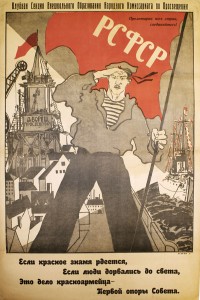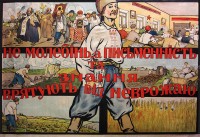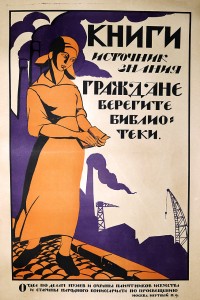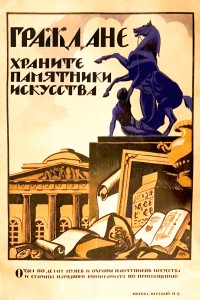Narkompros (People’s Commissariat for Education)
The People's Commissariat for Education (Narkompros) was formed in 1918 and it encompassed the former Imperial Ministry of Public Education, the State Education Committee, and the former Palace Ministry (an entity that managed theaters, the Academy of Arts and the royal palaces). Overseeing Narkompros was the All-Russian Central Executive Committee (VTsIK). As the main educational branch of the government, Narkompros carried out a compliment of programs such as the combating of illiteracy, professional education, adult education, and increasing public arts through its Proletkult (proletarskaya kultura) division. In 1922, state censorship was regulated via the office of Glavlit (Main Administration for Literature and Publishing of the People's Commissariat for Education)-- the censorship authority over Narkompros. Referred to as "control"; all publishing, live performances and public speeches were scrutinized by Narkompros editorial boards for potential security risks. Anatoli Lunacharskii, an art critic, author and journalist, headed Narkompros until 1929. In 1946, Narkompros was re-organized as the Ministry of Education.
Sources & Citations
Jaffé, D. (2012). Historical dictionary of Russian music. Lanham: Scarecrow Press. (P. 244, People’s Commissariat of Public Education, bio)
Leach, R. (1994). Revolutionary theatre. London: Routledge. (section on Proletkult)
Koenker, D., et al. (1989). Party, state, and society in the Russian Civil War: Explorations in social history. Bloomington: Indiana University Press. (section on Narkompros)
Fitzpatrick, S. (1970). The commissariat of enlightenment: Soviet organization of education and the arts under Lunacharski. Cambridge: Cambridge University Press. (sections on Narkompros and on Anatoli Lunacharskii)
![PP 139: Only soviet rule can lead working masses to light and enlightenment.
[Posted by] the Club Section of the Extramural Department of the Commissariat of Public Education.](https://www.posterplakat.com/thumbs/the-collection/posters/pp-139/pp139-200x299.jpg)
![PP 468: The Workers’ Club is the Hearth of Revolutionary Thought. [Bottom left] Club Section of the Extramural Department of the Commissariat of Public Education.](https://www.posterplakat.com/thumbs/the-collection/posters/pp-468/pp468-200x297.jpg)


![PP 861: Lenin and the Peasantry.
“The industrious peasant is a central figure in our economic development.” – Lenin
[Partial translation]](https://www.posterplakat.com/thumbs/the-collection/posters/pp-861/pp-861-catalog-image-200x147.jpg)

